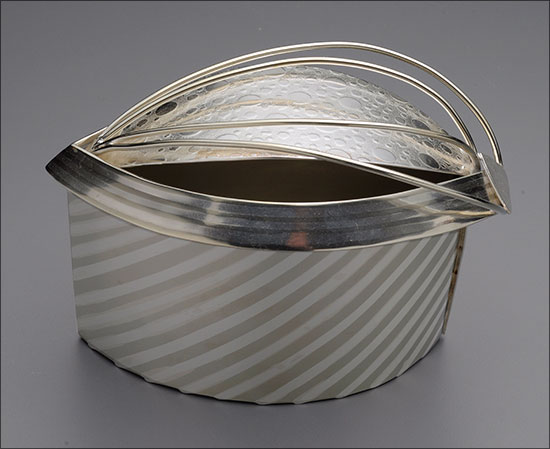Materials: nickel, sterling
Dimensions: 4" long, 2" wide, 4" tall
Made of nickel with sterling wire inlayed into and then roller-printed for the lid. Nickel and sterling were soldered together and rolled to created striped sheets that were fabricated into the box and handle.
Photo credit: Charley Freiberg
Joy Raskin
Metal Ornaments
Bedford, NH. USA
A native New Englander, I need all my metalwork to have a function. Boxes have a special appeal to me for they are small containers that can be beautifully made, but they all hold something, whether it is special to the person, or to admire as a small sculpture. The clean lines of architecture, the everchanging urban landscape, the geometry of bridges and structures, time travel, deep space all inspires me and provides me a fertile ground to draw ideas from. I love stripes, lines, geometric patterns, curves, the marquise shape and I try to use them as much as I can in my work. I always try to have a marquise shape in almost all of my work, whether it is the actual form or an accent. As the Bauhaus philosophy preaches, “Less is More”, that also applies to me. Strip the form down to it’s very basic lines and then carefully add onto it without losing the original form. Boxes are a wonderful way of letting me express my love of geometric patterns, my shapes and more, all wrapped up in one little container. I think of myself as making 21st century cabinets of curiousities.
These containers and vessels definitely hold their place in the world of stunning art objects as well as in the world of metalsmithing.
Since the dawn of time humans have created containers to hold things that were important to them, from large vessels to hold food and harvests to intimate containers for small precious things. They might hold memories, ashes, medicine, beverage, fruit or food - but all spring from the imagination and skill of the maker. Some have specific religious functions, some are meant for everyday use. When one thinks of a vessel or container the inclination is to think of something with solid walls - yet many of these works involve the exploration of positive and negative space, and the use of negative space to help create the illusion of the wall of the vessel.
As the world’s largest jewelry related internet site, Ganoksin strives to develop exhibitions showcasing work from around the world. This exhibition was open to all metalsmiths, professional and amateur, advanced and beginner. Participants are from The Netherlands, the USA, Canada, Australia, Costa Rica, the United Kingdom, Israel, Hong Kong, Colombia, Romania, Italy, Ireland, Japan, Malaysia and Denmark. While most of the pieces are by an individual metalsmith, some are collaborations, one of three artists spanning 50 years.
In total 319 artists contributed 729 show pieces for the permanent online exhibition.
Objects in the exhibition include boxes, lockets, urns, ash containers, bowls, wine cups, reliquaries, match holders, vases, teapots, pitchers, sugar bowls, baskets, nests, pillboxes, clutches and a range of sculptural forms. A variety of techniques are showcased covering a wide range of metalsmithing techniques. Materials used include everything from gold and silver to less expensive metals. Ornamentation includes the addition of enamel, chasing and repousse’, gemstones and found objects.
The exhibition was curated by Beth Wicker, President of the North Carolina Society of Goldsmiths in the United States, and Adjunct Instructor at Northeastern Technical College in South Carolina. Director of the exhibition is Hanuman Aspler, founder of The Ganoksin Project, the world’s largest internet jewelry site.
